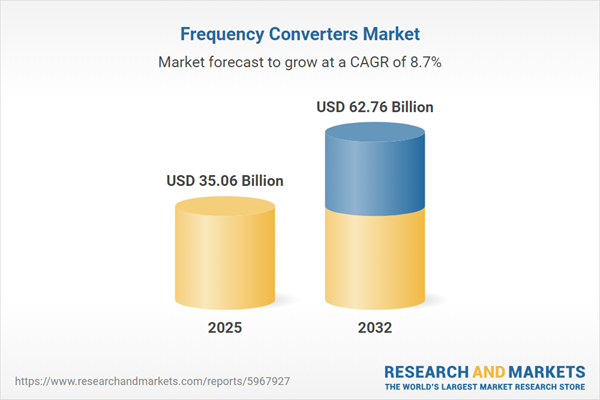Speak directly to the analyst to clarify any post sales queries you may have.
Frequency converters are essential for industrial and commercial operations, enabling precise control over motor speeds, energy optimization, and improved system reliability. As businesses strive to advance operational efficiency and embrace digitalization, the global frequency converter market is positioned at the core of this transformation.
Market Snapshot: Frequency Converter Market Growth and Dynamics
The Frequency Converters Market grew from USD 32.26 billion in 2024 to USD 35.06 billion in 2025. With an expected CAGR of 8.67%, the market is projected to reach USD 62.76 billion by 2032, reflecting strong growth driven by modernization initiatives, energy management imperatives, and technological innovation.
Scope & Segmentation
This report comprehensively analyzes the frequency converter industry across product types, regional markets, and technology trends:
- Phase – Single phase and three phase applications catering to light commercial, residential, and heavy industrial sectors
- Cooling Type – Solutions ranging from air cooled for ease of installation to liquid cooled for high-density, high-performance environments
- Mounting Mode – Flexible options including floor mounted for robust applications and wall mounted for compact, retrofit-friendly installations
- End Use – Diverse adoption across automotive, manufacturing, marine, and oil and gas industries, each with tailored requirements
- Control Method – Technologies such as sensorless vector control, V/F control, and vector control, including closed loop and open loop variants, supporting application-specific needs
- Technology – Analysis of current source inverter, pulse amplitude modulation, and various PWM converter topologies (including three-level and two-level PWM)
- Power Rating – Products spanning below 10 kW for microdrives through mid-range, up to high-capacity converters above 500 kW, supporting a broad spectrum of power requirements
- Regional Coverage – Detailed breakdown for Americas (United States, Canada, Mexico, Brazil, Argentina, Chile, Colombia, Peru), Europe, Middle East & Africa (including United Kingdom, Germany, France, Russia, Italy, Spain, Netherlands, Sweden, Poland, Switzerland, United Arab Emirates, Saudi Arabia, Qatar, Turkey, Israel, South Africa, Nigeria, Egypt, Kenya), and Asia-Pacific (China, India, Japan, Australia, South Korea, Indonesia, Thailand, Malaysia, Singapore, Taiwan)
- Company Profiles – Strategic review of major players: ABB Ltd, Siemens AG, Schneider Electric SE, Rockwell Automation, Inc., Mitsubishi Electric Corporation, Danfoss A/S, Yaskawa Electric Corporation, Fuji Electric Co., Ltd., Toshiba Corporation, Hitachi, Ltd
Key Takeaways: Strategic Insights for Decision-Makers
- Frequency converters have evolved from basic power controllers to intelligent, networked devices supporting predictive maintenance, asset analytics, and greater process autonomy.
- Advancements in wide-bandgap semiconductors and digital control algorithms are driving enhancements in device performance, energy savings, and equipment lifespan.
- Regulatory pressures, including stricter harmonics standards and energy-efficiency benchmarks, are accelerating adoption of advanced converter topologies with real-time diagnostics and active filtering.
- Ongoing shifts in global supply chains, particularly due to tariffs on semiconductor and core components, are fueling realignment of sourcing, assembly, and vendor strategies, while incentivizing investment in next-generation, high-efficiency topologies.
- Industry 4.0 integration is fostering demand for converters with built-in industrial Ethernet, OPC UA, and fieldbus communication, positioning these assets as data gateways for holistic plant and facility management.
- Market competitiveness is increasingly shaped by R&D depth, cross-industry collaborations, and differentiated service models such as remote monitoring and subscription-based maintenance.
Tariff Impact: Navigating New Supply Chain Realities
The introduction of United States tariffs on frequency converter components has reshaped procurement and production strategies. Manufacturers are pursuing nearshoring, diversifying supplier bases, and accelerating innovation in converter designs to balance cost pressures, resilience, and long-term operational savings. This supply chain transformation is enabling agile competitors to emerge with streamlined production and heightened market responsiveness.
Research Methodology & Data Sources
Our analysis is grounded in a robust methodology that integrates primary interviews with industry leaders and technical experts, complemented by secondary reviews of industry publications, standards, patent filings, and company reports. Insight validation leverages cross-source triangulation and rigorous quantitative techniques for data integrity and reliability.
Why This Report Matters
- Guides leadership teams in formulating supply chain, R&D, and technology investment strategies within the frequency converter market.
- Provides actionable insight into shifting regulatory and competitive frameworks impacting global sourcing, technology adoption, and service differentiation.
- Enables prioritization of digital transformation, energy optimization, and modular design initiatives to seize emerging opportunities and build resilience.
Conclusion
This analysis equips industry stakeholders with a comprehensive view of the evolving frequency converter market landscape. Strategic insights informed by rigorous research support forward-looking decision-making and long-term competitive strength.
Additional Product Information:
- Purchase of this report includes 1 year online access with quarterly updates.
- This report can be updated on request. Please contact our Customer Experience team using the Ask a Question widget on our website.
Table of Contents
3. Executive Summary
4. Market Overview
7. Cumulative Impact of Artificial Intelligence 2025
Companies Mentioned
The companies profiled in this Frequency Converters market report include:- ABB Ltd
- Siemens AG
- Schneider Electric SE
- Rockwell Automation, Inc.
- Mitsubishi Electric Corporation
- Danfoss A/S
- Yaskawa Electric Corporation
- Fuji Electric Co., Ltd.
- Toshiba Corporation
- Hitachi, Ltd
Table Information
| Report Attribute | Details |
|---|---|
| No. of Pages | 198 |
| Published | November 2025 |
| Forecast Period | 2025 - 2032 |
| Estimated Market Value ( USD | $ 35.06 Billion |
| Forecasted Market Value ( USD | $ 62.76 Billion |
| Compound Annual Growth Rate | 8.6% |
| Regions Covered | Global |
| No. of Companies Mentioned | 11 |









